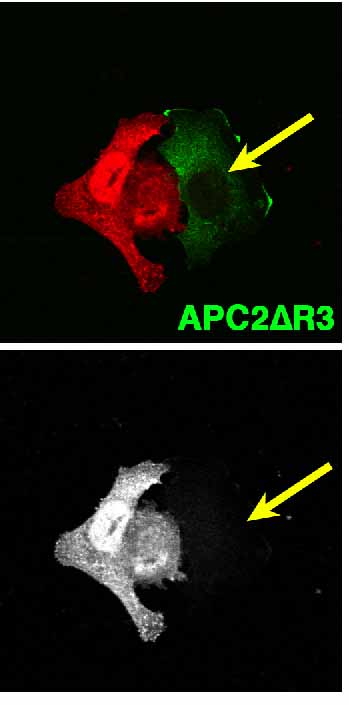Mira Pronobis Alumna Page

Background & Contact Information
Currently: Postdoctoral Fellow, Ken Poss lab, Duke University
Graduate Student, Curriculum in Genetics and Molecular Biology (2010 – Present)
Education: Diplom, University of Karlsruhe, 2010
Fellowships & Awards: HHMI International Student Fellowship
Email: mirapro@email.unc.edu
DOWNLOAD CV
 Research Information
Research Information
Mutations in the tumor suppressor Adenomatous Polyposis Coli (APC) initiate the formation of most colon tumors. APC is a key regulator of the canonical Wnt-pathway, a signal transduction pathway involved in a number of cellular processes including proliferation and cell fate decisions. The key regulated step in the Wnt-pathway is the regulation of the transcriptional co-activator ß-catenin. In the “Off”-state, ß-catenin is constitutively targeted for degradation in the proteasome by a multi-protein complex called the “destruction complex”. release of ß-catenin from the destruction complex. Another model proposed that binding of APC protects ß-catenin from dephosphorylation in the cytoplasm, which would block proteasomal degradation. Other models suggest APC acts in the mucleus to export ß-catenin or repress Wnt-regulated genes
I am using the human colorectal cancer cell line SW480 to test these models of APC function, I am expressing in this cell line mutant versions of the Drosophila APC family member APC2. These either lack individual protein domains or mis-localize APC2 to particular intracellular locations. In parallel, we are analyzing these same mutants in vivo in the fruit fly. Our data are inconsistent with current models suggesting high-affinity ßcatenin-binding sites on APC play key roles. Instead, they suggest multiple ßcatenin-binding sites act additively to fine-tune signaling via cytoplasmic retention. We identify essential roles for two putative binding sites for new partners—20-amino-acid repeat 2 and conserved sequence B—in destruction complex action. Finally, we demonstrate APC interacts with Axin by two different modes and provide evidence that conserved sequence B helps ensure release of APC from Axin, with disassembly critical in regulating ßcatenin levels. Using these data, we suggest a new model for destruction complex action in development, which also provides new insights into functions of truncated APC proteins in cancer.
Publications
- Pronobis, M.I., Deuitch, N., Posham, V., Mimori-Kiyosue, Y. and Peifer, M. (2016). Reconstituting regulation of the canonical Wnt pathway by engineering a minimal βcatenin destruction machine. Molecular Biology of the Cell, in press.
- Pronobis, M.I., Deuitch, N., and Peifer, M. (2016). The Miraprep: A protocol that uses a Miniprep kit and provides Maxiprep yields. PLoS One 11, e0160509.
- Pronobis, M.I., Rusan, N.M., and Peifer, M. (2015). A novel GSK3-regulated APC:Axin interaction regulates Wnt signaling by driving a catalytic cycle of efficient βcatenin destruction. eLife 4, e08022.
- Roberts,D.M., Pronobis, M.I., Alexandre, K.M., Rogers, G.C., Poulton, J.S., Schneider, D.E., Jung, K.-C., McKay, D.J., and Peifer, M. (2012). Regulation of Wnt signaling by the tumor suppressor APC does not require ability to enter the nucleus nor a particular cytoplasmic localization. PLoS One 7: e31284.
- Roberts,D.M., Pronobis, M.I., Poulton, J.S., Kane,E.G., and Peifer, M. (2012). Regulation of Wnt signaling by the tumor suppressor APC does not require ability to enter the nucleus nor a particular cytoplasmic localization. Molecular Biology of the Cell 23, 2041-56
- Pronobis, M.I., and Peifer, M. (2012) Wnt signaling: The many interfaces of ß-catenin. Current Biology 22, R137-139.
- Roberts,D.M., Pronobis, M.I., Poulton, J.S., Waldmann, J.D., Stephenson, E.M., Hanna, S., and Peifer, M. (2011). Deconstructing the ßcatenin destruction complex: mechanistic roles for the tumor suppressor APC in regulating Wnt signaling. Molecular Biology of the Cell 22, 1845-1863.


